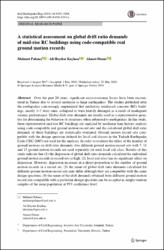| dc.contributor.author | Palancı, Mehmet | en_US |
| dc.contributor.author | Kayhan, Ali Haydar | en_US |
| dc.contributor.author | Demir, Ahmet | en_US |
| dc.date.accessioned | 2019-05-28T11:35:01Z | |
| dc.date.available | 2019-05-28T11:35:01Z | |
| dc.date.issued | 2018-11 | |
| dc.identifier.citation | Palanci, M., Kayhan, A. H., & Demir, A. (2018). A statistical assessment on global drift ratio demands of mid-rise RC buildings using code-compatible real ground motion records. Bulletin of Earthquake Engineering, 16(11), 5453-5488. doi:10.1007/s10518-018-0384-y | en_US |
| dc.identifier.issn | 1570-761X | |
| dc.identifier.issn | 1573-1456 | |
| dc.identifier.uri | https://hdl.handle.net/20.500.12294/1413 | |
| dc.description | Palancı, Mehmet (Arel Author) | en_US |
| dc.description.abstract | Over the past 20years, significant socio-economic losses have been encountered in Turkey due to several moderate to large earthquakes. The studies published after the earthquakes concurringly emphasized that multistory reinforced concrete (RC) buildings, mostly 3-7 story ones, collapsed or were heavily damaged as a result of inadequate seismic performance. Global drift ratio demands are mostly used as a representative quantity for determining the behavior of structures when subjected to earthquakes. In this study, three representative mid-rise RC buildings are analyzed by nonlinear time history analysis using code-compatible real ground motion record sets and the calculated global drift ratio demands of these buildings are statistically evaluated. Ground motion record sets compatible with the design spectrum defined for local soil classes in the Turkish Earthquake Code (TEC-2007) are used for the analyses. In order to evaluate the effect of the number of ground motions on drift ratio demands, five different ground motion record sets with 7, 11 and 15 ground motion records are used separately for each local soil class. Results of this study indicate that (1) the dispersion of global drift ratio demands calculated for individual ground motion records in record sets is high, (2) local soil class has no significant effect on dispersion. However, dispersion increases in a direct proportion to the number of ground motion records in a record set, (3) the mean of global drift ratio demands calculated for different ground motion record sets may differ although they are compatible with the same design spectrum, (4) the mean of the drift demands obtained from different ground motion record sets compatible with a particular design spectrum can be accepted as simply random samples of the same population at 95% confidence level | en_US |
| dc.language.iso | eng | en_US |
| dc.publisher | Springer | en_US |
| dc.relation.ispartof | Bulletin Of Earthquake Engineering | en_US |
| dc.identifier.doi | 10.1007/s10518-018-0384-y | en_US |
| dc.identifier.doi | 10.1007/s10518-018-0384-y | |
| dc.rights | info:eu-repo/semantics/openAccess | en_US |
| dc.subject | RC Buildings | en_US |
| dc.subject | Nonlinear Dynamic Analysis | en_US |
| dc.subject | Statistical Evaluation | en_US |
| dc.title | A statistical assessment on global drift ratio demands of mid-rise RC buildings using code-compatible real ground motion records | en_US |
| dc.type | article | en_US |
| dc.department | İstanbul Arel Üniversitesi, Mühendislik ve Mimarlık Fakültesi, İnşaat Mühendisliği Bölümü | en_US |
| dc.identifier.volume | 16 | en_US |
| dc.identifier.issue | 11 | en_US |
| dc.identifier.startpage | 5453 | en_US |
| dc.identifier.endpage | 5488 | en_US |
| dc.relation.publicationcategory | Makale - Uluslararası Hakemli Dergi - Kurum Öğretim Elemanı | en_US |


















